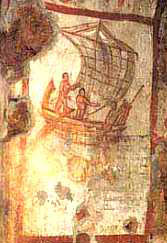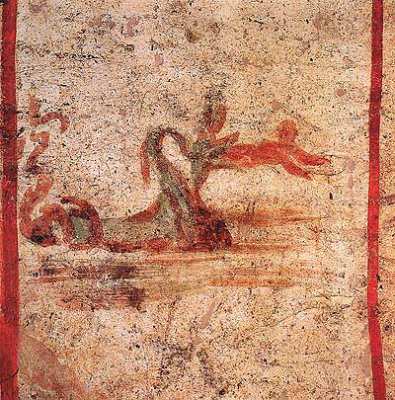The 4th-century ivory above is typical of the period. On the right Jonah's fellow passengers toss him into the sea, where a sea monster comes to swallow him. On the far left the monster has delivered him up to the land. To the right of that, he sleeps under a gourd tree.2 The next morning, he learns from God the lesson of the gourd. Jonah had complained that after God made him prophesy doom for Nineveh he relented upon seeing their repentance. So God gives him a shade tree for a day. When the tree dies and Jonah whines about it, God's reply closes the book: "Thou art grieved for the ivy, for which thou hast not laboured, nor made it to grow, which in one night came up, and in one night perished. And shall not I spare Ninive, that great city, in which there are more than a hundred and twenty thousand persons…and many beasts?"
This sequence of events that we see in the ivory above was especially favored in 3rd- and 4th-century sarcophagi, which merged it into the imagery of Baptism, the gateway to resurrection (Jensen, "Baptismal Imagery," 154). One way of suggesting Jonah's connection with Baptism was to show him naked as the sailors toss him into the sea (example). In the baptismal ritual, catechumens were stripped naked before immersion in the baptismal pool (Senn, 94). Another was to re-imagine Jonah's time under the gourd tree as the blessed state awaiting the baptized and resurrected soul. In this 4th-century sarcophagus, for example, a scene of Jonah beneath the tree overlaps with one of Peter baptizing his jailers: first Baptism in this life, then Paradise in the next.
Jonah's reclining pose under the gourd tree is adapted from classical iconography that poses the naked sleeper frontally with legs crossed and one arm raised over the head while the weight of the body rests on the other arm and the left hip. Examples include images of Endymion and Selene and Bacchus and Ariadne. Dionysus also lies in this pose in a Campanian terracotta in the Louvre (Ferguson, 349). And the Metropolitan Museum has this late classical carving of a "heroic male nude" in almost the same pose but as if seen from above. Not a few critics have constructed theories interpreting Jonah's pose by relating it to Endymion's, but the use of the pose for so many other classical figures makes it less likely that the Jonah artists had Endymion specifically in mind. More likely is Ferguson's conclusion (346) that "the bucolic setting was evidently taken as pointing to paradise, and the round gourd was a symbol of health."
Ferguson's take on the meaning of the scene is borne out especially by the Jonah Sarcophagus in the Vatican, where the scene is just one part of a vision of material abundance surely meant to symbolize the spiritually abundant life promised to the baptized Christian. In this setting, Jensen suggests that Jonah's nudity is like Adam's before the Fall and signifies "an innocence restored" (Baptismal Imagery, 154-55). Indeed, there is a suggestion that Jonah's innocence even surpasses that of Adam. The sarcophagi never show Adam's genitals; Jonah's are always shown in the gourd-tree scenes and in at least one example as he emerges from the sea monster, but never in the scenes where he goes into the maw of the beast.
Duchet-Suchaux (198) counts no fewer than 57 images of the sequence of Jonah episodes in catacomb frescoes (some samples are at right), and as we have seen they are very common on the sarcophagi of the 3rd and 4th centuries. As Ferguson (343-46) has shown, the story is also presented in practically every other medium, including plaques, frescoes, mosaics, sculpture (example), an ivory box, and so on during the paleo-Christian era.
But afterwards the art makes less and less use of the three-scene sequence and especially of the gourd-tree scene. In the Middle Ages Jonah will be modestly dressed when he goes into the drink (example), and the connection with Baptism appears to be nearly forgotten. That sacrament is not mentioned once, for example, in the Glossa Ordinaria's extensive survey of exegeses on the Book of Jonah (IV, 1919-1940). I did find a manuscript illumination in which Jonah emerges from the fish "born again" as a blessed babe. But for the most part medieval art gives us Jonah only in group images of the prophets (example), where there is no occasion to allude to Resurrection or any other theme from the story. This is certainly true of this Renaissance sculpture, where the nudity is back but without any religious signification.
Prepared in 2014 by Richard Stracke, Emeritus Professor of English, Augusta University, revised 2015-06-14.
HOME PAGE
The bottom register of the Murano Diptych
IN THE CATACOMBS (Follow the links for full image and description):

Jonah is cast into the sea. (See the description page.)

Images of the prophet in the Cubiculum of Jonah. (See the description page.)
MORE IMAGES
- 4th century: A floor mosaic in Aquileia, Italy, with the episodes of Jonah swallowed by the sea monster, delivered to the shore, and lying under the gourd tree.
- 325-75: Details in a dome painting in Egypt show Jonah being thrown overboard and Jonah beneath the gourd tree.
- 12th or 13th century: In a stained glass window in Canterbury Cathedral a panel picturing the entombment of Christ is accompanied by its typological counterpart, the swallowing of Jonah by the great fish. Then, above the entombment panel, an image of the resurrection is accompanied by one of Jonah exiting from the fish and heading toward Nineveh.
- 14th century: A relief at Orvieto Cathedral has a figure that could be Jonah, sleeping under a stylized ivy tree while the eleven other "minor prophets" prophesy the coming of Christ.
- 1475: The Jonah panel in the rood screen at Santa Maria Gloriosa dei Frari, Venice.
- Circa 1489-1515: A merely generic portait of Jonah in Santa Maria dei Miracoli, Venice.
NOTES
1 In the Greek text used by early Christians the creature is called a ketos, which means "whale" specifically but "sea monster" in general. The sea-monster slain by Perseus is labeled ketos in
this detail
from a vase of the 6th century BC. Ancient Greek images of the ketos give it the same split tail, coiled body, and long, narrow snout seen in paleo-Christian images of the creature that swallowed Jonah
(example). Jesus also calls it a ketos in Matthew 12:40. The original Hebrew used a word meaning "great fish," and that is what the Latin Vulgate followed in the late 4th century, rendering it piscem grandem. Thus I shall use the term "sea monster" for discussions of pre-Vulgate images and "great fish" for those created after the 4th century.
2 It is a gourd tree in the Greek text and in the art of the 3rd and 4th centuries, with broad leaves and fruit of the characteristic gourd shape. The Latin Vulgate, however, calls the plant a hedera, "ivy."
